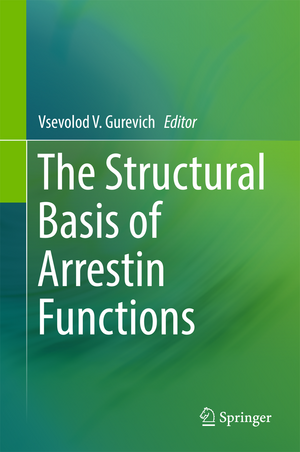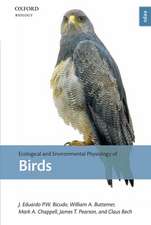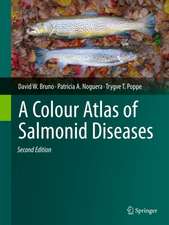The Structural Basis of Arrestin Functions
Editat de Vsevolod V. Gurevichen Limba Engleză Hardback – 6 iun 2017
This volume summarizes our current understanding of the structural basis of the functions of arrestin family of proteins. Arrestins were first discovered as key players in the desensitization of G protein-coupled receptors (GPCRs). Recent studies showed that arrestins are important signal transducers in their own right, organizing multi-protein complexes and scaffolding numerous signaling cascades that regulate cell proliferation, differentiation, and apoptotic death.
Here arrestin functions are described primarily from the structural prospective. The book covers basal structure of arrestin proteins, receptor binding-induced conformational changes in arrestins, as well as the structure of “pre-activated” mutants. Particular focus is on the arrestin elements interacting with numerous binding partners, GPCRs and cytoplasmic signaling proteins. We expect that this information and insights will help to understand and exploit the phenomenon of signaling bias, which is a new promising direction in drug discovery.
The chapters are written by the world-class specialists in the field, mostly the people who actually contributed the data discussed. The book gives coherent historical prospective and describes the most recent findings.
The book would be particularly useful for scientists in academia and industry working in the fields of pharmacology, cell biology, structural biology, and drug discovery. We expect that the focus on the molecular basis of protein-protein interactions would help to develop novel tools for engaging this important type of targets for research and therapeutic purposes.
| Toate formatele și edițiile | Preț | Express |
|---|---|---|
| Paperback (1) | 785.49 lei 39-44 zile | |
| Springer International Publishing – aug 2018 | 785.49 lei 39-44 zile | |
| Hardback (1) | 799.51 lei 39-44 zile | |
| Springer International Publishing – 6 iun 2017 | 799.51 lei 39-44 zile |
Preț: 799.51 lei
Preț vechi: 1051.98 lei
-24% Nou
Puncte Express: 1199
Preț estimativ în valută:
152.99€ • 163.60$ • 127.56£
152.99€ • 163.60$ • 127.56£
Carte tipărită la comandă
Livrare economică 14-19 aprilie
Preluare comenzi: 021 569.72.76
Specificații
ISBN-13: 9783319575520
ISBN-10: 331957552X
Pagini: 304
Ilustrații: IX, 304 p. 53 illus., 51 illus. in color.
Dimensiuni: 155 x 235 mm
Greutate: 0.67 kg
Ediția:1st ed. 2017
Editura: Springer International Publishing
Colecția Springer
Locul publicării:Cham, Switzerland
ISBN-10: 331957552X
Pagini: 304
Ilustrații: IX, 304 p. 53 illus., 51 illus. in color.
Dimensiuni: 155 x 235 mm
Greutate: 0.67 kg
Ediția:1st ed. 2017
Editura: Springer International Publishing
Colecția Springer
Locul publicării:Cham, Switzerland
Cuprins
Arrestins: discovery of the family and functional role of conformational flexibility.- Overview of arrestin-mediated signaling with receptors and non-receptor binding partners.- Initial crystallographic studies of visual arrestin: insights and perspectives.- Structural basis for b-arrestins in GPCR trafficking.- Arrestin-3: the structural basis of lower receptor selectivity.- Phosphate sensor and construction of phosphorylation-independent arrestins.- Comprehensive analysis of the role of arrestin residues in receptor binding.- How arrestin recognizes and binds active GPCRs.- Localization of conformational dynamics of arrestins by HDX-MS.- GPCR footprint on arrestins and manipulation of receptor specificity.- The structure of the polar core mutant R175E and its functional implications.- Active conformations of arrestins: expected and unexpected changes.- The arrestin-receptor complex: exciting answers and new questions.- Scaffolding c-Jun N-terminal kinase cascades: mechanistic insights from the reconstituted arrestin-JNK cascades.- Arrestin-dependent ERK activation and its disruption.- The functional role of the conformational changes in arrestin upon activation.- Is signaling specificity encoded in arrestin conformation?.- Monofunctional elements of multi-functional arrestin proteins.- Arrestins in cell death.
Notă biografică
Dr. Gurevich got his PhD in Bioorganic Chemistry at the Shemyakin Institute in Moscow. He studied structure and function of arrestin proteins since he joined the lab of Dr. Benovic as a post-doc in 1991. Dr. Gurevich’s studies revealed why arrestins prefer active phosphorylated GPCRs and how they sense receptor-attached phosphates. His lab constructed phosphorylation-independent arrestin mutants and tested their ability to compensate for the defects of GPCR phosphorylation. His lab elucidated the structural basis of arrestin preference for particular GPCRs and constructed the first non-visual arrestins with high receptor specificity. In collaboration with different crystallographers Dr. Gurevich’s lab solved the structures of all four vertebrate arrestins in basal conformation and the structure of the arrestin-rhodopsin complex.
Textul de pe ultima copertă
This volume summarizes our current understanding of the structural basis of the functions of arrestin family of proteins. Arrestins were first discovered as key players in the desensitization of G protein-coupled receptors (GPCRs). Recent studies showed that arrestins are important signal transducers in their own right, organizing multi-protein complexes and scaffolding numerous signaling cascades that regulate cell proliferation, differentiation, and apoptotic death.
Here arrestin functions are described primarily from the structural prospective. The book covers basal structure of arrestin proteins, receptor binding-induced conformational changes in arrestins, as well as the structure of “pre-activated” mutants. Particular focus is on the arrestin elements interacting with numerous binding partners, GPCRs and cytoplasmic signaling proteins. We expect that this information and insights will help to understand and exploit the phenomenon of signaling bias, which is a new promising direction in drug discovery.
The chapters are written by the world-class specialists in the field, mostly the people who actually contributed the data discussed. The book gives coherent historical prospective and describes the most recent findings.
The book would be particularly useful for scientists in academia and industry working in the fields of pharmacology, cell biology, structural biology, and drug discovery. We expect that the focus on the molecular basis of protein-protein interactions would help to develop novel tools for engaging this important type of targets for research and therapeutic purposes.
Caracteristici
Gives a unique insight of the connection between protein structure and function of arrestin and its broad implications
Discussed are structure-based redesign of signalling proteins paves the way for novel approaches to gene therapy
Presents a unified view of the structural basis of the various branches of arrestin-mediated signalling
Includes supplementary material: sn.pub/extras
Includes supplementary material: sn.pub/extras
Discussed are structure-based redesign of signalling proteins paves the way for novel approaches to gene therapy
Presents a unified view of the structural basis of the various branches of arrestin-mediated signalling
Includes supplementary material: sn.pub/extras
Includes supplementary material: sn.pub/extras














